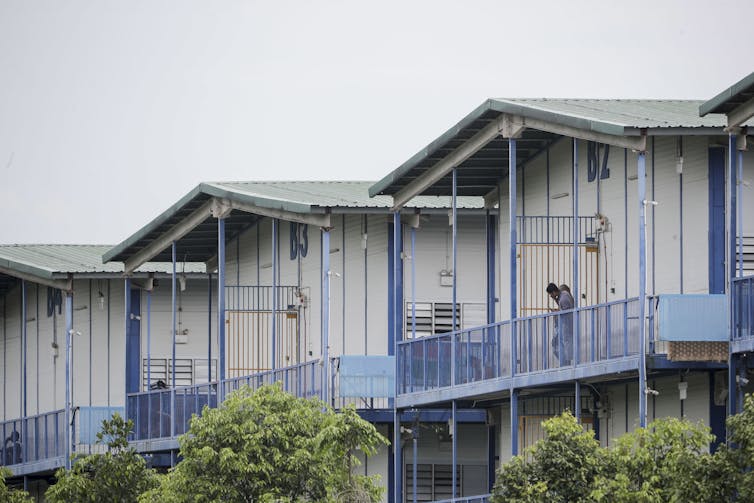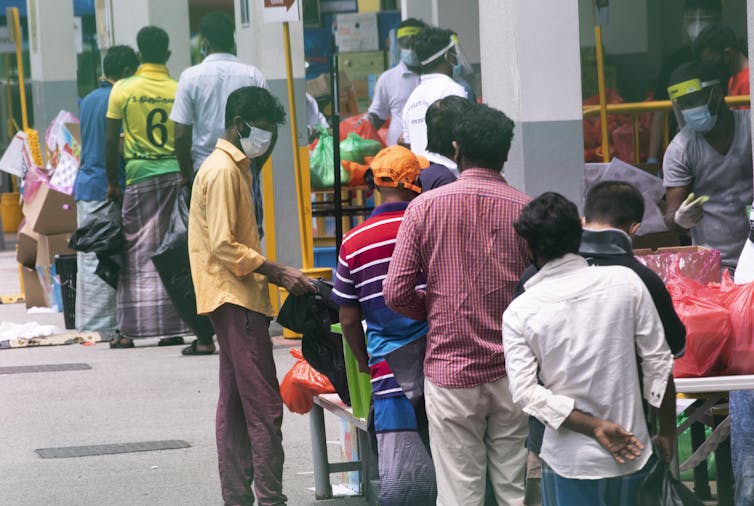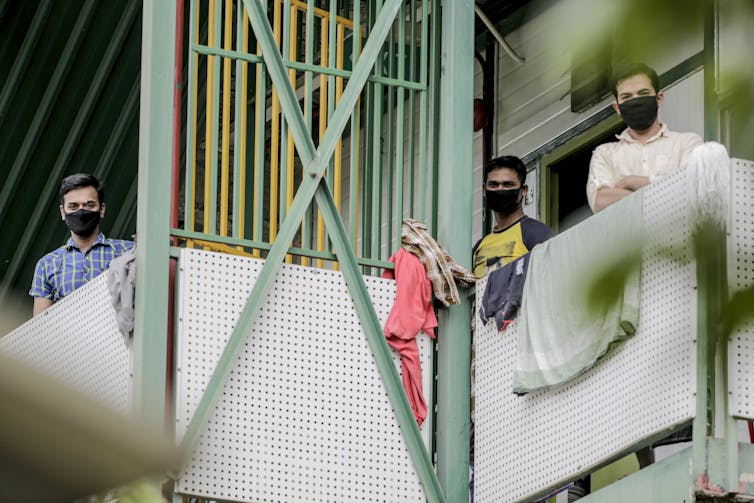Singapore's population in 2018 was 5.639 million. Let us say it is about 5.75 million in 2020.
Singapore has a highly developed Free Market economy and is seen as most pro business and least corrupt with extremely low Tax rates of less than 15% of GDP and Singapore's GDP was 363 Billion US Dollars in 2019, on par with Hongkong and Malaysia with much larger populations.
Singapore's per capita GDP is of the order of US $ 63,987.
If we look at Singapores GDP by sector agriculture is 0%, Industry is 24.8% and services in 75.2%. Being a small island nation there is hardly any land for people to live resulting in high rise apartments and agriculture is unknown to the people of Singapore. Everything that is consumed by Singaporeans is fully imported. Singapore has achieved a higher per capita GDP compared to USA whose GDP is about US$ 21 trillion.
All credit for this economic success of Singapore goes to The First Prime Minister of Singapore Lee Kuan Yew, a Lawyer turned politician who served as Prime Minister from 1959 to 1990

Lee Kuan Yew,
Former Prime Minister of Singapore
In Virtually every group discussion over the years, amongst my Indian friends LKYs name always came up and we would ask the question why cannot India learn a few lessons from LKY of Singapore. That is how highly revered he was as a visionary leader of a small Island nation
How LKY Transformed Singapore : -
Exclusive Interview with LKY:-
You have to watch the video that follows and Listen to PM Lee Kuan Yew speak as it is so very relevant to Singapore to day in May 2020
Quoting PM Lee Kuan Yew's words "the Present generation below 35 has grown up used to high economic growth, year after year and they take security and success for granted and because they believe all is well they are less willing to make sacrifices for the benefit of others in the society and they are more concerned about individual and family's welfare and success and not the Communities or societies well being. But this is very dangerous and things can go terribly wrong terribly quickly. These people are not aware of Singapore's vulnerabilities and happy to have a No 1 airport, sea port airline etc. He dreamt of a Society based on Justice and equality. I will let you watch the full video and you will agree Lee Kuan Yew was a God Send for Singaporeans.
Justice and Equality in Singapore in 2020 is a Myth at best.
Now watch the following video and tell me if there is Justice and equality in Singapore today.
In Dec 2019 the total foreign work force in Singapore was 1,427,500 people
Let us take a look at the plight of 1.7 million migrant workers in Singapore and the wretched condition under which they survive.
Foreign Workers in Singapore from China. click on this link to read this article
"Many have to endure abuse, discrimination and violations of their rights but few can obtain legal redress," the report says. "Their movements, behavior and even their ‘moral conduct,' are tightly controlled by their boss, who can terminate their employment and send them back to China at anytime and without any justification."
Now Read this article in Conversation: "This is why Singapore’s coronavirus cases are growing: a look inside the dismal living conditions of migrant workers April 30, 2020 6.06am AEST
Excerpt: "But the increasing COVID-19 infection rates among migrant workers suggest there is another side to the tight regulation that governs nearly every aspect of life in Singapore – the institutionalised neglect of the country’s 300,000-plus migrant workers".
And it is this neglect that, my research suggests, lies at the heart of explanations for Singapore’s COVID-19 crisis.
Full Article from Conversation follows:
In recent weeks, Singapore went from global success story in its response to the coronavirus outbreak to having the largest number of cases in Southeast Asia.
There are some 15,000 confirmed cases in Singapore as of this week – more than Japan, South Korea and Indonesia.
Most startlingly, though, is the number of migrant worker infections in the country, which dwarfs that of the general population. For example, of the 528 new cases detected on Tuesday, 511 were foreign workers living in dormitories, while another seven were workers living outside the dormitories.
Singapore’s approach to disease mitigation, generally speaking, mirrors the country’s approach to just about everything – control, surveillance and containment.
Read more: Why Singapore's coronavirus response worked – and what we can all learn
But the increasing COVID-19 infection rates among migrant workers suggest there is another side to the tight regulation that governs nearly every aspect of life in Singapore – the institutionalised neglect of the country’s 300,000-plus migrant workers.
And it is this neglect that, my research suggests, lies at the heart of explanations for Singapore’s COVID-19 crisis.
 The majority of Singapore’s COVID-19 infections are among foreign workers in dormitories. Wallace Woon/EPA
The majority of Singapore’s COVID-19 infections are among foreign workers in dormitories. Wallace Woon/EPACramped rooms with one toilet for 80 men
In 2014-15, I carried out a large study of transient migrant workmen from India and Bangladesh in Singapore, interviewing close to 200 men over 18 months. Most worked in the construction and shipping industries, and some in the landscaping and cleaning sectors.
As well as uncovering stories of routine labour exploitation and debt bondage among the workers, I also found most workers’ living conditions were shockingly substandard.
Employers are supposed to provide meals for migrant workers, for example, but workers complained the food was often no more than soggy rice and gravy. Often, it was spoiled and inedible.
 Migrant workers lining up to collect their food at a dormitory in Singapore. How Hwee Young/EPA
Migrant workers lining up to collect their food at a dormitory in Singapore. How Hwee Young/EPAMy research also found substandard accommodation greatly compounded the difficulties these workers faced.
Many migrant workers live in the cramped, purpose-built dormitories (PBDs) shown in media reports in recent days.
These dormitories only became common a couple of years ago when migrant-rights organisations began focusing on housing conditions of workers. The government’s response was to build large dormitories in remote, outlying areas.
This enabled the government to claim it had addressed criticisms of poor worker housing. At the same time, it ensured these workers were further separated spatially and socially from the rest of Singapore’s population.
This separation has been an ongoing concern of the government since the so-called “Little India riots” of 2013, which broke out after a migrant worker was knocked down and killed by a bus. More than 50 police officers and eight civilians were hurt, and dozens of Indian workers were either charged with offences or sent home.
Read more: Riots in Singapore as it struggles to juggle growth and migration
But not all, or even the majority, of workers live in dormitories. Many live on the upper floors of small construction subcontracting firms, or in shipping containers and other temporary housing on work sites.
The conditions are abhorrent: cramped rooms housing up to 30 men apiece, no air-conditioning or appropriate ventilation, bed bugs and cockroaches, and often just one filthy toilet shared by more than 80 people.
In both dormitories and these accommodations, two men often rotate on one bed. When the day-shift worker returns to the room to sleep, he takes the place of the night-shift worker using the same bed.
In these conditions, dengue and other waterborne diseases thrive. A few weeks before I arrived in Singapore in 2012, there was a massive outbreak of dengue among migrant workers in the industrial northwest. Many men were infected, and most swiftly deported.
In 2015, I visited a factory where five Bangladeshi men were pursuing a case for unpaid salary against their employer. They told me previous workers had contracted dengue and were deported while they were still sick. As a result, they were pushed by their boss to work longer hours, despite not being paid. The deportation of injured and sick workers is a common occurrence in Singapore.
These living and working conditions explain why we are seeing such high rates of COVID-19 infections now. The government’s main response has been the construction of several large dormitories for workers, but beyond that, it has yet to take comprehensive steps to improve conditions.
The government does have a salary and injury claims system for migrant workers, but NGOs in the country claim it – like policies to improve workers’ living conditions – is woefully inadequate.
 Workers have largely been restricted to their dormitories since the pandemic worsened. Wallace Woon/EPA
Workers have largely been restricted to their dormitories since the pandemic worsened. Wallace Woon/EPAWorkers now very afraid of COVID-19
Last week, one of the participants in my research, a 32-year-old Bangladeshi man named Monir, sent me an email saying:
We are in lockdown for two months. Can’t go out. Singapore very danger now. But we are lucky we not stay worker’s dormitory. We sleep Geylang [a district of Singapore] company store.
During the current crisis, the workers in the dormitories are currently only allowed outside their rooms at certain times to reduce contact with others. Some have been relocated to offshore, floating accommodations where they are similarly confined.
Debbie Fordyce, a longtime migrant worker rights advocate, told me,
When returning Singapore students were give a two-week holiday in five-star hotels rather than be a potential source of infection to their family, these men are being bunched together with a far higher vulnerability than if they were in a space alone or with fewer people.
The government should have been better prepared for a possible outbreak among these workers. Instead, it turned a blind eye to their needs.
When the government issued face masks to all Singaporeans at the fist sign of COVID-19 in early February, migrant workers were excluded. (The philanthropic arm of a state investor later distributed more than 1 million masks to migrant workers and domestic helpers.)
Read more: Refugees need protection from coronavirus too, and must be released
Last week, the government imposed a stay-at-home order for 180,000 migrant workers in the construction industry until May 4, confining them to their dormitories. Advocacy groups have warned about quarantining large groups of people together like this, comparing it to cruise ships.
While recent media coverage on the COVID-19 crisis in Singapore has exposed the substandard conditions of migrant workers, my study shows there is a longer history of institutionalised neglect of these men.
This is not an exceptional time for these workers – their rights have long been ignored because they are transient and, for the most part, deemed disposable.
xxxxxxxxxxxxxxxxxxxxxxxxx
Singapore is not a land of milk and honey, as there are no cows or bees in Singapore :-) , but a Land of $$$$ and strict law and order;
My Question is Why does the Singapore Govt not address the Migrant Problem and why don't they have a Minimum wage for these foreign workers
According to Singapore's Ministry of Manpower, Singapore does not have minimum wage and "salary is subject to negotiation and mutual agreement between an employer and an employee or the trade union representing the employees".
The Question is why ? Why does the Singapore Govt allow pimps and touts to exploit foreign workers ? This Body shopping business has to stop as it stinks.
How are these foreign workers any different from the Galley Slaves of the Roman Empire ?

Or The Black African Slaves of America

I am Proud to call myself an Australian Citizen as it is a Nation that cares for its people and believes in dignity of labour and yes Australia has a Minimum Wage Policy which is follows.
The Minimum Wage In Australia
Understanding minimum wages in Australia is one of the most important elements to maintaining an effective cost structure when running a business. There are certain standards set in place by the Fair Work Commission which dictates minimum grades of pay for different job roles across all industries, and if you aren’t fully aware of each of your employees’ minimum wages, you could find yourself underpaying them.
The current minimum wage in Australia is $740.80 per week, which equates to a minimum hourly rate of $19.49. The minimum wage is the absolute lowest that an employee can be paid. This minimum wage was set on May 30, 2019 and must be adhered to by all businesses operating in Australia.
Every year on 1 July Australia’s minimum wage changes, subject to a decision by the Fair Work Commission.
Capitalistic societies, meaning an economic and political system in which a country's trade and industry are controlled by private owners for profit, rather than by the state thrive on the blood sweat and tears of fellow human beings who are transparent and invisible to the affluent population.
The seedy side of this Foreign workers in Singapore is exploitation of women who are forced into the sex trade by the pimps and the touts who call themselves Labour Contractors
How can we Indians and Chinese Citizens of Singapore choose to close a Blind eye and inflict such misery on our own country men and women?
Shame on ya Singapore.
Time for the people of Singapore to stand up and tell the Govt that this is not acceptable. Each and every human being in Singapore needs to be protected by law and guaranteed a minimum wage. May be Singapore Citizens should start a petition and get a million Signatures.
Every year on 1 July Australia’s minimum wage changes, subject to a decision by the Fair Work Commission.
Capitalistic societies, meaning an economic and political system in which a country's trade and industry are controlled by private owners for profit, rather than by the state thrive on the blood sweat and tears of fellow human beings who are transparent and invisible to the affluent population.
The seedy side of this Foreign workers in Singapore is exploitation of women who are forced into the sex trade by the pimps and the touts who call themselves Labour Contractors
How can we Indians and Chinese Citizens of Singapore choose to close a Blind eye and inflict such misery on our own country men and women?
Shame on ya Singapore.
Time for the people of Singapore to stand up and tell the Govt that this is not acceptable. Each and every human being in Singapore needs to be protected by law and guaranteed a minimum wage. May be Singapore Citizens should start a petition and get a million Signatures.